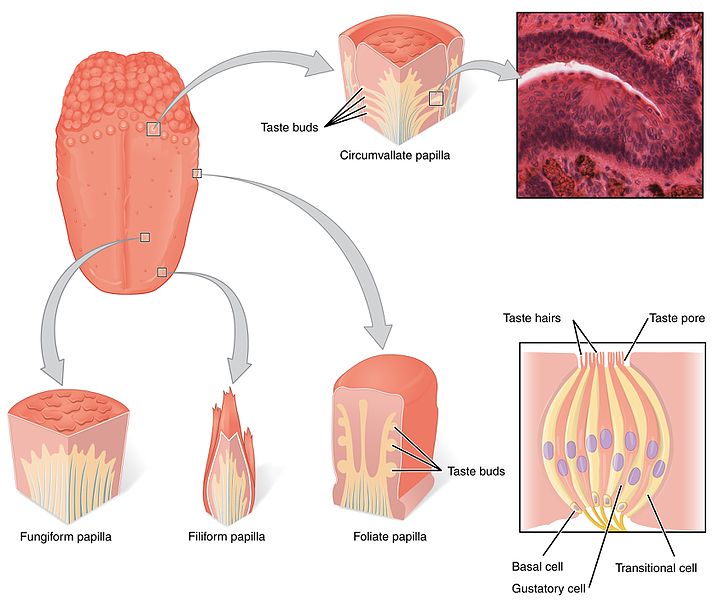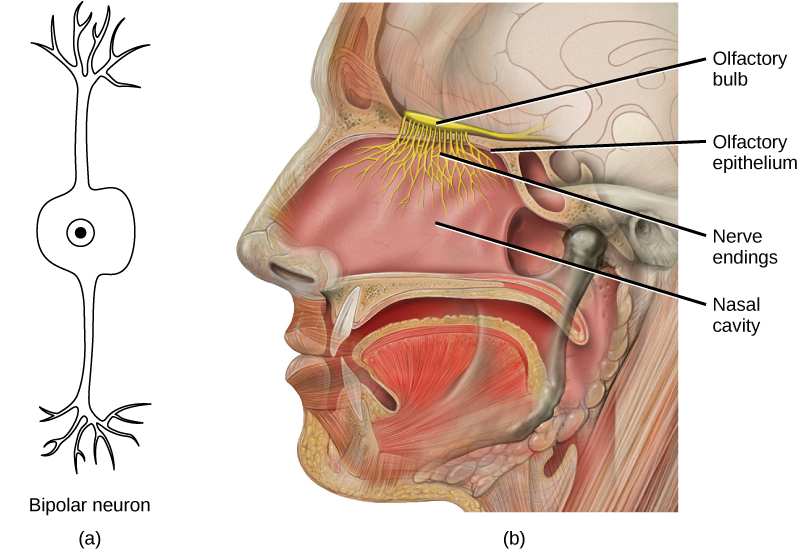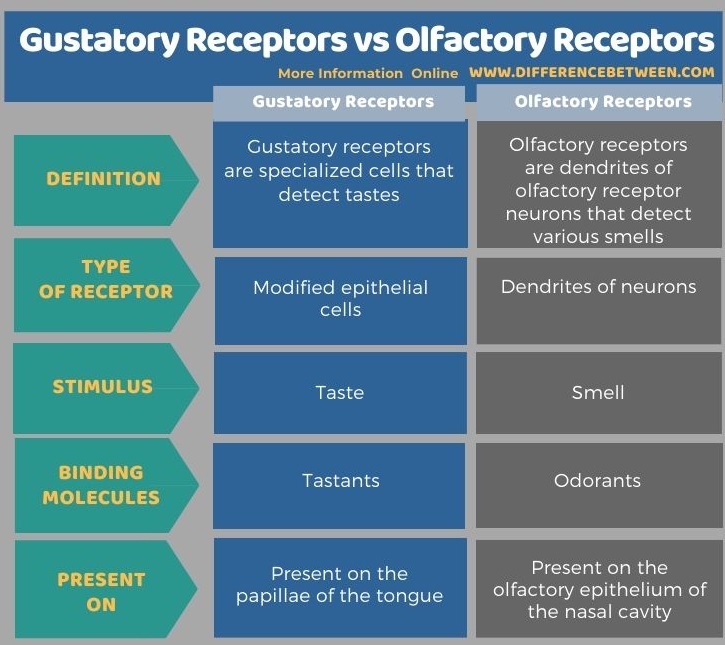The key difference between gustatory receptors and olfactory receptors is that gustatory receptors are modified epithelial cells that are capable of binding with tastants while olfactory receptors are dendrites of neurons that are capable of binding with odour molecules.
Gustatory receptors and olfactory receptors are two types of sensory receptors. Gustatory receptors are specialized taste cells that receive taste stimuli. They are found in the papillae of the tongue. In contrast, olfactory receptors are specialized chemo-receptors that receive various smell stimuli. They are found on the olfactory epithelium of the nasal cavity. Structurally, taste receptors are modified epithelial cells, while olfactory cells are dendrites of true neurons.
CONTENTS
1. Overview and Key Difference
2. What are Gustatory Receptors
3. What are Olfactory Receptors
4. Similarities Between Gustatory Receptors and Olfactory Receptors
5. Side by Side Comparison – Gustatory Receptors vs Olfactory Receptors in Tabular Form
6. Summary
What are Gustatory Receptors?
Taste or gustation is a sense. Gustatory receptors are a specialized group of chemoreceptors that detect tastants in the food. They are found on the papillae of the tongue. The surface of the tongue is lined by the stratified squamous epithelium, and the papillae are the raised bumps that have taste buds. There are three types of papillae as circumvallate, foliate, and fungiform. The number of taste buds may vary within the papilla. Each taste bud contains several specialized taste cells or gustatory receptor cells. We can also see gustatory receptors in the palate and early parts of the digestive system like the larynx and upper oesophagus.

Figure 01: Gustatory Receptors
Gustatory receptors mainly identify five different taste sensations, including sweet, salty, bitter, sour, and umami. Salty and sour taste sensations are detected through direct diffusion while sweet, bitter, and umami tastes are detected by way of G protein-coupled taste receptors. Taste cells release neurotransmitters. Neurotransmitters activate sensory neurons in the facial, vagus and glossopharyngeal cranial nerves.
What are Olfactory Receptors?
Olfactory receptors present in the back of the nasal cavity are responsible for the sense of smell or olfaction. In fact, olfactory receptors are found on the olfactory epithelium. Olfactory receptors or odorant receptors are smell receptors that bind and detect air-borne odour molecules that enter the nasal cavity. They are dendrites of specialized neurons. Once odour molecules bind with olfactory receptors, they send impulses directly to the olfactory bulb of the brain.

Figure 02: Olfactory Receptors
There are hundreds of different types of olfactory receptors in the human body. Moreover, olfactory receptors are present in very large numbers (millions). In each receptor, there is an external process (cilia) extending out to the surface of the epithelium.
What are the Similarities Between Gustatory Receptors and Olfactory Receptors?
- Gustatory receptors and olfactory receptors are sensory receptors.
- They bind with their respective ligands.
What is the Difference Between Gustatory Receptors and Olfactory Receptors?
Gustatory receptors are taste receptor cells that detect taste stimuli. In contrast, olfactory receptors are true neurons that detect various smells. So, this is the key difference between gustatory receptors and olfactory receptors. Moreover, gustatory receptors are present on the papillae of the tongue, while olfactory receptors are present on the olfactory epithelium of the nasal cavity.
The below infographic summarizes the difference between gustatory receptors and olfactory receptors.

Summary – Gustatory Receptors vs Olfactory Receptors
Gustatory receptors are specialized taste cells found in the taste buds (papillae) of the tongue. Gustatory cells respond to taste stimuli. In contrast, olfactory cells are dendrites of neurons found on the olfactory epithelium of the nasal cavity. They detect various smells. Thus, this is the key difference between gustatory receptors and olfactory receptors.
Reference:
1. “Special Senses: Taste (Gustation) | Anatomy And Physiology I”. Courses.Lumenlearning.Com, 2020, Available here.
2. “Olfactory Receptor”. Sciencedirect.Com, 2020, Available here.
Image Courtesy:
1. “1402 The Tongue” By OpenStax – (CC BY 4.0) via Commons Wikimedia
2. “Figure 36 03 01” By CNX OpenStax – (CC BY 4.0) via Commons Wikimedia
ncG1vNJzZmivp6x7pbXFn5yrnZ6YsqOx07CcnqZemLyue8OinZ%2Bdopq7pLGMm5ytr5Wau26z1Kyrmqyfp8ZuvsScnKmsn6fAbq3NnWSopJaWsLW70bJkq52Tmr21u9GsZg%3D%3D